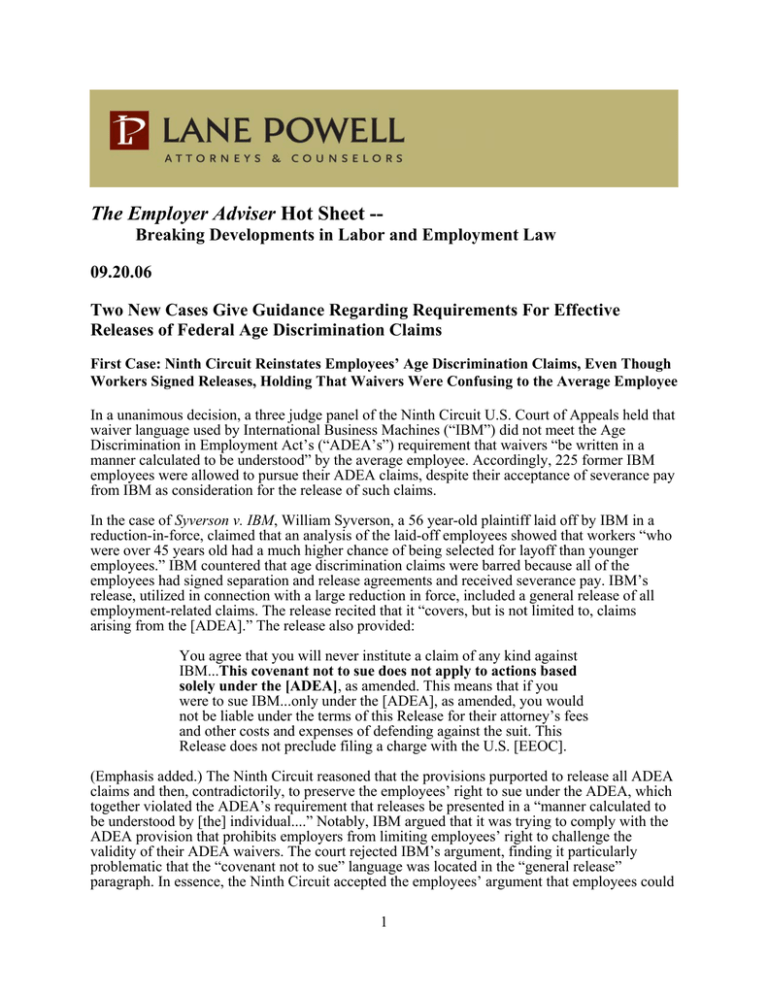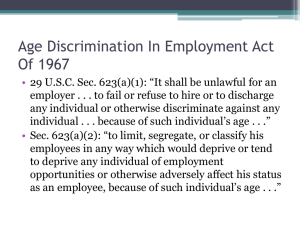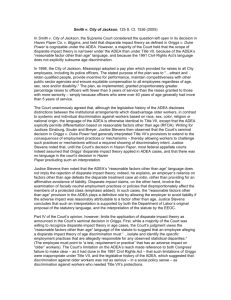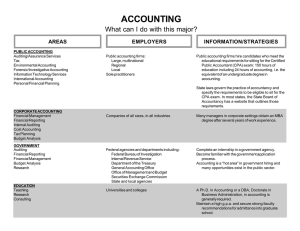The Employer Adviser
advertisement

The Employer Adviser Hot Sheet -Breaking Developments in Labor and Employment Law 09.20.06 Two New Cases Give Guidance Regarding Requirements For Effective Releases of Federal Age Discrimination Claims First Case: Ninth Circuit Reinstates Employees’ Age Discrimination Claims, Even Though Workers Signed Releases, Holding That Waivers Were Confusing to the Average Employee In a unanimous decision, a three judge panel of the Ninth Circuit U.S. Court of Appeals held that waiver language used by International Business Machines (“IBM”) did not meet the Age Discrimination in Employment Act’s (“ADEA’s”) requirement that waivers “be written in a manner calculated to be understood” by the average employee. Accordingly, 225 former IBM employees were allowed to pursue their ADEA claims, despite their acceptance of severance pay from IBM as consideration for the release of such claims. In the case of Syverson v. IBM, William Syverson, a 56 year-old plaintiff laid off by IBM in a reduction-in-force, claimed that an analysis of the laid-off employees showed that workers “who were over 45 years old had a much higher chance of being selected for layoff than younger employees.” IBM countered that age discrimination claims were barred because all of the employees had signed separation and release agreements and received severance pay. IBM’s release, utilized in connection with a large reduction in force, included a general release of all employment-related claims. The release recited that it “covers, but is not limited to, claims arising from the [ADEA].” The release also provided: You agree that you will never institute a claim of any kind against IBM...This covenant not to sue does not apply to actions based solely under the [ADEA], as amended. This means that if you were to sue IBM...only under the [ADEA], as amended, you would not be liable under the terms of this Release for their attorney’s fees and other costs and expenses of defending against the suit. This Release does not preclude filing a charge with the U.S. [EEOC]. (Emphasis added.) The Ninth Circuit reasoned that the provisions purported to release all ADEA claims and then, contradictorily, to preserve the employees’ right to sue under the ADEA, which together violated the ADEA’s requirement that releases be presented in a “manner calculated to be understood by [the] individual....” Notably, IBM argued that it was trying to comply with the ADEA provision that prohibits employers from limiting employees’ right to challenge the validity of their ADEA waivers. The court rejected IBM’s argument, finding it particularly problematic that the “covenant not to sue” language was located in the “general release” paragraph. In essence, the Ninth Circuit accepted the employees’ argument that employees could 1 be misled into believing that the “carve-out” for ADEA claims from the covenant not to sue also nullified their release of ADEA claims and rendered their release inoperative to extinguish those claims. The Ninth Circuit also rejected IBM’s argument that “the direction to consult an attorney or an IBM employee mitigates confusing waiver language.” What Syverson Means for Employers Employers should review their current separation and release agreements to make certain the agreements do not include a “confusing” combination of general release language and covenant not to sue language that excludes ADEA claims. ADEA releases still must permit the releasing employee to challenge or seek a determination in good faith of the validity of any waiver under the ADEA. Employers should consult with counsel about the language of their ADEA releases. Second Case: Eleventh Circuit Limits Older Workers Benefit Protection Act Data Disclosure Requirements Syverson is not the only new development regarding ADEA releases. Under the Older Workers Benefit Protection Act (“OWBPA”), employers are required to provide employees affected by a reduction in force, or similar group termination program, with information regarding the eligibility criteria for the program. This includes the disclosure of job titles and ages of employees selected for discharge. Failure to provide the required information can be a basis for invalidating an employee’s release of ADEA claims. What has not been entirely clear is the required scope of this information; i.e., whether the information must be “company-wide” for a company-wide layoff, or whether the information can be limited to the “decisional unit.” In Burlison v. McDonald’s Corp., the Eleventh Circuit has issued a decision providing employers with some much-needed guidance. In Burlison, the plaintiffs were long-time employees of McDonald’s, age 40 or older, who were terminated in conjunction with a 2001 nationwide restructuring in which McDonald's reduced its workforce by approximately 500 employees. Each of the employees accepted a severance package in exchange for signing a release of all claims against McDonald’s, including ADEA claims. Pursuant to the OWBPA, McDonald’s provided the information regarding the employees selected for discharge, including region-specific data. McDonald’s did not provide its employees with selection data regarding other employees outside their region. Notwithstanding having signed ADEA releases and accepting their severance pay, the employees filed suit against McDonald’s challenging their termination and the validity of their ADEA releases. The district court granted summary judgment for the plaintiffs, finding that the releases violated the OWBPA because McDonald’s provided only regional, and not company-wide, data. On appeal, the Eleventh Circuit rejected plaintiffs’ argument and concluded that the company was only required to disclose data for the “decisional unit,” which the opinion defined as: ...that portion of the employer’s organizational structure from which the employer chose the persons who would be offered consideration for the signing of a waiver and those who would not be offered consideration for the signing of a waiver. The court observed that employers only need to provide employees enough data to conduct an evaluation of potential age discrimination claims before releasing such claims. In Burlison, the regional manager selected the employees in the region for layoff, so region-wide information was sufficient. 2 What Burlison Means for Employers Employers should ensure that they provide enough data regarding job titles and ages of selected employees to comply with the OWBPA. While employers may limit this data to a “decisional unit,” they should be prepared to defend their definition of “decisional unit.” For this reason, employers should consider carefully the scope of the decision maker's authority when determining the scope of a “decisional unit.” If the decision maker is selecting employees for layoff firm-wide, departmental or regional data may be insufficient. The “decisional unit” will differ from employer to employer, and from program to program, depending on the specific circumstances of the employer’s reduction in force. For more information, please contact the Labor and Employment Law Practice Group at Lane Powell: 206.223.7000 Seattle 503.778.2100 Portland employlaw@lanepowell.com www.lanepowell.com We provide The Employer Adviser Hot Sheet as a service to our clients, colleagues and friends. It is intended to be a source of general information, not an opinion or legal advice on any specific situation, and does not create an attorney-client relationship with our readers. If you would like more information regarding whether we may assist you in any particular matter, please contact one of our lawyers, using care not to provide us any confidential information until we have notified you in writing that there are no conflicts of interest and that we have agreed to represent you on the specific matter that is the subject of your inquiry. © 2006 Lane Powell PC Seattle - Portland - Anchorage - Olympia – Tacoma - London Lawyers for Employers ™ 3







